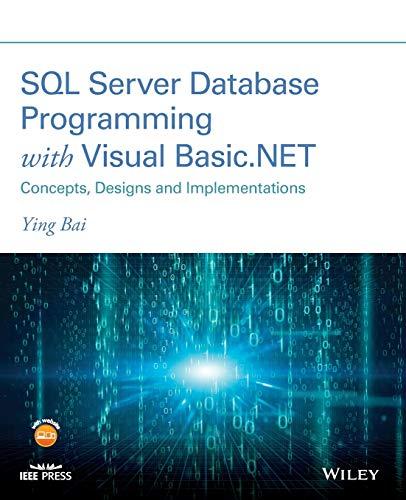Question
Create a new Java project and add the Account class into the source code. Create a JUnit test class, AccountTest, and write test cases which
Create a new Java project and add the Account class into the source code.
Create a JUnit test class, AccountTest, and write test cases which exercise all the methods of the Account class.
Compile your classes and run the JUnit tests.
If your tests reveal any defects in the logic of the Account class, report them.
here are account.java file
import java.text.NumberFormat; /** * Account is a bank account with basic services for deposit, * withdrawal, and interest. */ public class Account { private NumberFormat fmt = NumberFormat.getCurrencyInstance(); private final float kInterestRate = 0.045f; // interest rate of 4.5% private long acctNumber; private float balance; public final String name; /** * Sets up the account by defining its owner, account number, * and initial balance. * @param owner name of account holder * @param account the account number, an identifier for the account * @param initial the initial amount of money in the account. */ public Account(String owner, long account, float initial) { name = owner; acctNumber = account; balance = initial; } /** * Deposit the specified amount into the account. * @param amount value to be added to the balance * @return true if amount is non-negative, false if amount * is negative; indicates balance was not changed. */ public boolean deposit(float amount) { boolean result = true; // is amount invalid? if (amount < 0) { result = false; } else { balance = balance + amount; } return result; } /** * Withdraw the specified amount from the account, * unless amount is negative, fee is negative, or * amount exceeds current balance. * @param amount value to be deducted from the balance * @param fee the transaction fee debited from the account * @return true if transaction was successful, false otherwise; */ public boolean withdraw(float amount, float fee) { // validate parameters if (isValidWithdrawl(amount, fee)) { amount += fee; balance = balance - amount; } return isValidWithdrawl(amount, fee); } /* Determine if withdrawal parameters are valid */ private boolean isValidWithdrawl(float amount, float fee) { return amount >= 0 && fee >= 0 && amount <= balance; } /** * Adds interest to the account. */ public void addInterest() { balance += (balance * kInterestRate); } /** * Accessor to the current balance of the account. * @return the current balance of the account. */ public float getBalance() { return balance; } /** * Accessor to the account number. * @return the account number. */ public long getAccountNumber() { return acctNumber; } /** * Returns a one-line description of the account as a string. * @return formatted account information */ public String toString() { return (acctNumber + "\t" + name + "\t" + fmt.format(balance)); } }
Step by Step Solution
There are 3 Steps involved in it
Step: 1

Get Instant Access to Expert-Tailored Solutions
See step-by-step solutions with expert insights and AI powered tools for academic success
Step: 2

Step: 3

Ace Your Homework with AI
Get the answers you need in no time with our AI-driven, step-by-step assistance
Get Started


